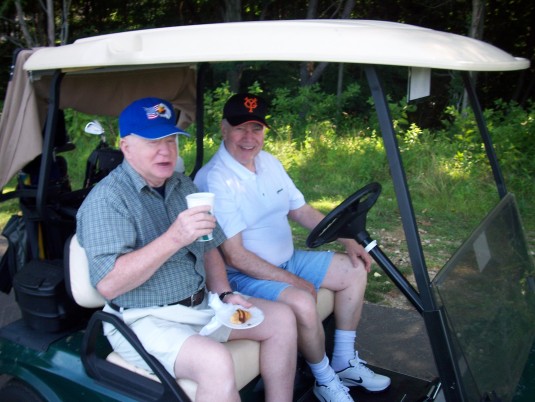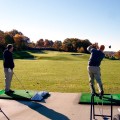
So you’d like to take-up golf? Or you’re a hacker like the rest of us? Maybe you’ve been playing awhile and hit a plateau in your play…Well join the club! Golf is really, really hard and I’ve found there is no silver bullet to rapidly improve your game.
I have been playing golf for almost twenty years and have some really good days and some not so good days. But there are some basic fundamentals I’ve learned over the years to help me take the frustration out of my game:
1. Take a lesson
Find yourself a good pro and take a lesson. If you’re starting from scratch, this will help you avoid learning a bunch of poor swing habits. Some community colleges offer courses like Golf 101, which could help defray some of the costs of a private lesson.
If you are further along with your skill-set, be wary of the local pro that might witness you on the range and say something to the effect that he or she has to “rebuild” your swing. When something like that happens (like it has to me), ask them how many lessons that rebuilding process is going to take. If they say anything like two or three lessons, tell them you’ll think about it. Rebuilding a “swing” is a process that could take an entire summer’s worth of lessons. So in those cases, they’re just trying to sell a few lessons.
Everybody’s swing is different and I’ve found a good instructor will build on the foundation of your swing and tweak it to gain consistency. Also there is a host of online materials that show you the basic fundamentals of the golf swing, like the one plane take away etc. Keep in mind these are businesses trying to sell you something as well.
2. Practice, practice, practice
Before you head-off to the driving range and just blast through a bucket of balls, you should practice with purpose. There are some techniques you can do to maximize your VPT (Valuable Practice Time).
The two main types of practice drills I’ve learned for the range are “Block” training and “Section” training. Block training is when you go through every club in your bag and hit a number of balls with each (I usually hit 5 balls per club – allowing an extra ball or two to not end on a bad shot). In this drill, I’ll usually start with my wedges and hit up through my bag, ending with my driver. This type training is good for shaking off the rust and gaining muscle memory.
The other driving range drill is “Section” training. As golf is a thinking game as much as a skill game, “Section” training is where you play a practice round in your head. You could even bring a scorecard from a favorite course and “walk” yourself through each hole. If you leave the range after “Section” training feeling uncomfortable, you’ve done your job! This drill can pay-off dividends on the course. And, don’t forget to hit the putting green after the range.
Reality check: Never assume you’ll hit good out on the course just because you were hitting them straight on the range…That’s the longest walk in golf. And keep in mind the pros have swing coaches and practice several hours a day because that’s their job. Most of us have non-golf-related careers and/or commitments and can’t spend the majority of the day at the range (if you like getting paychecks that is).
3. Play the shot not the score
No too long ago, playing “bogey” golf was a good respectable score. It wasn’t until the advent of modern professional golf that birdies and eagles became common occurrences. I always try and play a par four as a par five and I get less frustrated that way. Also, the wonders of the handicap system turns a gross bogey into a net par.
If you become too fixated on the score, you’ll have a tendency to force shots that could lead to more errors and heightened frustration.
Here’s a little secret to the way your mind works: You remember your birdies on a really hard hole, but mostly your subconscious remembers the great recovery shot you made after a really bad tee shot or second shot. Remember, golf is a game of recovery and there are many factors outside your control when playing (e.g. weather, mood, pace of play) that effect the round.
Know your limitations and don’t be so hard on yourself if you hit a bad shot. Stay positive and the scores will come – Bogey golf is still a good and respectable score for the average golfer.
4. Set realistic goals for yourself
Successful people set goals for themselves and find ways to obtain those goals. This is true in life as well as golf. Over the years, I set simple goals for my golf game and strived to meet them. One such goal was to play the same round with the same ball (took a few years but I finally did it)! Another was to break a hundred, which took a little bit longer to achieve. I have other goals, which I continue to work on to this day (e.g. hit fairways and greens in regulation, etc.).
Don’t be afraid to go out to your local course and play a practice round where you can use the whole scorecard to note tee shot, club hit & yardage, fairway hit <y/n>, greens in regulation <GIR> <y/n>, and number of putts. I have a local nine-hole course I use when I feel my swing slipping away. I feel totally comfortable playing there and I track my game and feel this helps me regain my confidence.
5. Have fun
Golf is supposed to be a fun and social sport. Most will not have the time nor skills to turn pro. Remember most pros practice hours a day with their caddies and swing coaches, as well as sport therapists. Ben Hogan reportedly hit 700-800 golf balls a day!
So our focus should be to have fun out there; play to our skill level; respect the rules; and exhibit etiquette for other players. Try not take it too seriously when you hit a bad shot and don’t let others’ negativity bring you down.
Enjoy the game of golf – it’s the most frustrating game you’ll ever love!




The main thing with golf is make sure you are having fun, once the fun stops invest in a golf lesson. Its amazing how a golf lesson can motivate any golfer but has to be with a qualified PGA professional that knows how to cater for your own personal goals with golf.
Before I gave it up, I did 18 months lesson program with Golf-Tec…then played a few months, last year..I started the lessons at +30 index, and finished at +30…no swing consistancy, no improvement in score or ability…Golf stopped being fun for me years ago…I just finally decided I can live without the Frustration and ruining my weekends..
Golf is not for everyone. Personally I play Golf to get exercise and be outdoors. Beats raking leaves on a beautiful fall day or mowing the lawn in the summer. I get real leary about places that guarantee immediate results. Some of those chain places want you to invest real money while they “rebuild” your swing. The best time to rebuild your swing is over the offseason using maybe a golf simulator. You still have to put the the practice time. Once a week isn’t going to cut it. You need to build that muscle memory, which could mean just swinging a club in your driveway after a snow storm. I prefer finding a teacher who you feel comfortable with and have him/her focus on repair. Also rebuilding ones swing your game might take a step backward, so buyer beware.